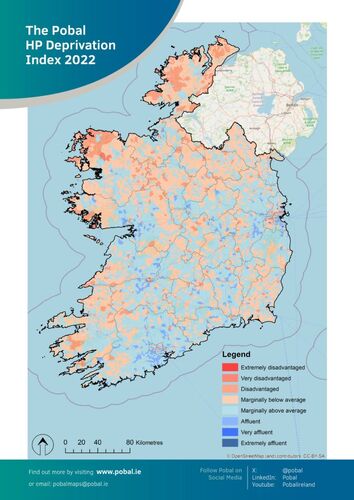 On November 2 nd , 2023 the 2022 Pobal HP Deprivation Index was launched by Joe O’Brien T.D., Minister of State for Community Development, Integration and Charities. The Index used data from Census 2022, analysing ten measures of an area’s levels of disadvantage. These include educational attainment, employment status and the numbers living in individual households. Almost 19,000 small areas (50-200 households) were indexed leading to the development of a detailed map of the relative affluence and disadvantage.
On November 2 nd , 2023 the 2022 Pobal HP Deprivation Index was launched by Joe O’Brien T.D., Minister of State for Community Development, Integration and Charities. The Index used data from Census 2022, analysing ten measures of an area’s levels of disadvantage. These include educational attainment, employment status and the numbers living in individual households. Almost 19,000 small areas (50-200 households) were indexed leading to the development of a detailed map of the relative affluence and disadvantage.
At the launch it was noted that:
- Nationwide there have been improvements in the majority of communities driven by measures such as employment and population growth, which overall has seen Ireland return to 2006 levels.
- However, many disadvantaged communities have not seen the same level of improvement, putting them further from the average in relative terms. The number of people living in areas classed as very or extremely disadvantaged has increased from 143,506 individuals to 195,992.
- Disadvantaged communities experience significantly higher levels of unemployment and low educational attainment, with higher rates of lone parents evident.
- Urban areas contain the highest proportion of both highly disadvantaged and highly affluent areas, while rural areas tend to see less of these extremes.
- Disadvantage is disproportionately experienced in small pockets in Dublin city centre, north and west suburbs, on the outskirts of Cork, Waterford and Limerick and in a small number of rural towns.
- Relative affluence, as measured by the Index, continues to be seen in South Dublin and in the commuter belts surrounding Dublin, Cork and Galway. New housing developments outside cities are also leading to new areas of affluence being recorded outside of traditional suburban areas.
On February 7 th , 2024 the INOU hosted an online meeting on the Pobal HP Deprivation Index, which over sixty people attended. Alana Ryan, Pobal Senior Research and Policy Officer and Martin Quigley, Director of Data & Analytics at Pobal were the presenters at this event.
They noted that the Index is:
- A tool to identify geographic disadvantage based on census data
- Available on Pobal Maps
- Used by Pobal, other Departments & State Agencies and researchers
- Data available for download at Electoral Division level on data.gov.ie, and at Small Area level on license with authors
The definition of deprivation Pobal uses states that: The fundamental implication of the term deprivation is of an absence – of essential or desirable attributes, possessions and opportunities which are considered no more than the minimum by that society. (Coombes et al., 1995)
The Index covers three subject matters: demographic vitality; social class composition; and labour market situation. These are derived from data on age dependency; population change; low or high educational attainment; employment / occupational status e.g. professional / managerial; person per room; people parenting alone; people with low skill levels; male or female unemployment.
One of the ways this Index is used is in the allocation of resources, for example in the SICAP and LEADER programmes. Its use in other areas would include Central Statistics Office (CSO) sampling; policy analysis and research by a range of organisations.
Further information on the Pobal HP Deprivation Index is available at https://www.pobal.ie/pobal-hp-deprivation-index/